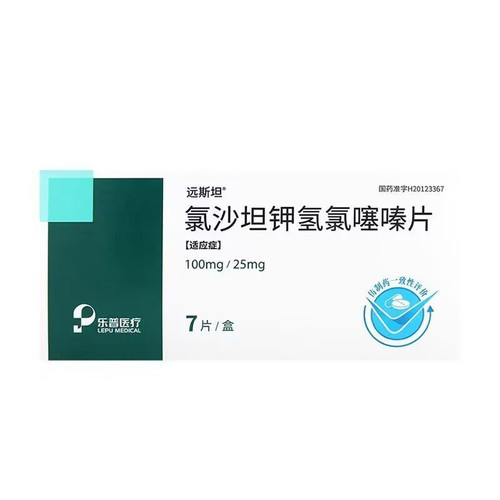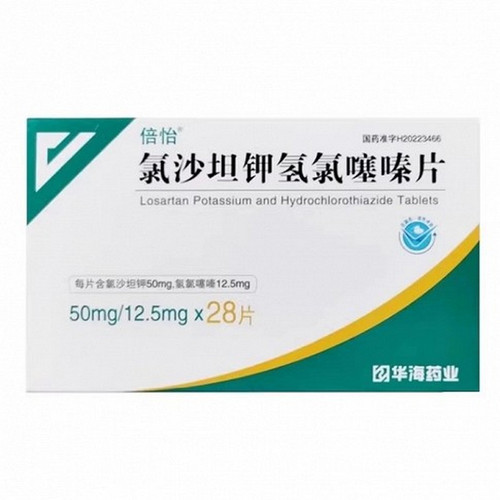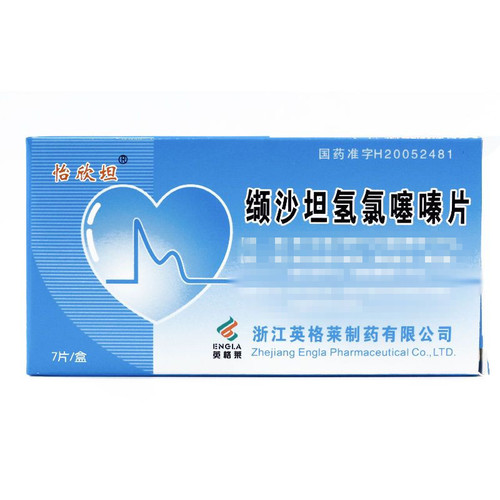Product Overview
[Drug Name]
Generic Name: Losartan Potassium and Hydrochlorothiazide Tablets
Trade Name: Nadia
English Name: Losartan Potassium and Hydrochlorothiazide Tablets
Chinese Pinyin: Lushatanjia Qinglusaiqin Pian
[Ingredients]
This product is a combination preparation. Each tablet contains 50 mg of losartan potassium and 12.5 mg of hydrochlorothiazide.
[Properties]
This product is a film-coated tablet. After removing the film coating, it appears white to off-white.
[Indications]
This product is used to treat hypertension and is suitable for patients receiving combination medications.
[Dosage and Administration]
The usual starting and maintenance dose of this product is one losartan potassium and hydrochlorothiazide tablet (50 mg + 12.5 mg) once daily. For patients with an inadequate response, the dose can be increased to two losartan potassium-hydrochlorothiazide tablets (50 mg + 12.5 mg) or one losartan potassium-hydrochlorothiazide tablet (100 mg + 25 mg) once daily, with this dose being the maximum daily dose. Antihypertensive effects are generally achieved within three weeks of starting treatment. This product should not be used in patients with volume depletion (such as those taking high-dose diuretics). It is not recommended for patients with severe renal insufficiency (creatinine clearance <30 mL/min) or hepatic insufficiency. For elderly hypertensive patients, no initial dose adjustment is required, but losartan potassium-hydrochlorothiazide tablets (100 mg + 25 mg) should not be used as initial treatment. This product can be taken in combination with other antihypertensive medications. It can be taken with or without food.
[Adverse Reactions]
No adverse reactions specific to this combination have been observed in clinical trials of losartan potassium-hydrochlorothiazide. These adverse reactions are limited to those previously reported for losartan potassium and/or hydrochlorothiazide. The overall incidence of adverse reactions with this combination was similar to that with placebo. The percentage of treatment discontinuations was also similar to that with placebo. Losartan potassium-hydrochlorothiazide was generally well tolerated. The vast majority of adverse reactions were mild and transient, not requiring treatment discontinuation. In controlled clinical trials of losartan potassium-hydrochlorothiazide for the treatment of essential hypertension, dizziness was the only adverse reaction reported as drug-related with an incidence greater than 1% and greater than that with placebo. Other post-marketing adverse reactions include: Hypersensitivity: Angioedema (including laryngeal and glottic edema leading to airway obstruction and/or swelling of the face, lips, pharynx, and/or tongue) has been reported rarely in patients treated with losartan; some of these patients had previously experienced angioedema with other medications, such as ACE inhibitors. Vasculitis, including Henoch-Schönlein purpura, has also been reported rarely with losartan. Gastrointestinal: Hepatitis has been reported rarely in patients treated with losartan, as has diarrhea. Respiratory: Cough has been reported with losartan. Skin: Urticaria. Laboratory Findings: In controlled clinical trials, clinically important changes in standard laboratory parameters were rarely associated with the use of losartan. Hyperkalemia (serum potassium >5.5 mEq/L) occurred in 0.7% of patients, but in these trials, discontinuation of losartan was not necessary. ALT elevations occurred rarely and generally resolved after discontinuation of losartan. The following adverse reactions are reported when losartan and hydrochlorothiazide are used alone and are therefore potential adverse reactions of losartan: Losartan: rash, dose-related orthostatic hypotension, abdominal pain, weakness/fatigue, chest pain, edema/swelling, palpitations, tachycardia, dyspepsia, nausea, back pain, muscle cramps, headache, insomnia, cough, nasal congestion, pharyngitis, sinus disorders, upper respiratory tract infection, migraine, abnormal liver function tests, anemia, thrombocytopenia, myalgia, arthralgia, and pruritus. Hydrochlorothiazide: Anorexia, gastrointestinal irritation, nausea, vomiting, cramps, diarrhea, constipation, jaundice (intrahepatic bile accumulation), pancreatitis, sialadenitis, dizziness, paresthesia, headache, xanthoopia, leukopenia, agranulocytosis, thrombocytopenia, aplastic anemia, hemolytic anemia, purpura, photosensitivity, fever, necrotizing vasculitis (angiitis) (cutaneous vasculitis), respiratory distress (including pneumonia and pulmonary edema), toxic epidermal necrolysis, hyperglycemia, glycosuria, hyperuricemia, electrolyte imbalances including hyponatremia and hyperkalemia, renal dysfunction, interstitial nephritis, renal failure, muscle cramps, weakness, restlessness, transient visual impairment.
[Contraindications]
Patients allergic to any component of this product. Patients with anuria. Patients allergic to other sulfonamides.
[Precautions]
1. Losartan potassium and hydrochlorothiazide should not be used in patients with reduced blood volume (such as those taking high-dose diuretics). 2. Losartan potassium hydrochlorothiazide is not recommended for patients with severe renal impairment (creatinine clearance ≤30 ml/min) or abnormal liver function. 3. No starting dose adjustment is required for elderly patients. 4. Losartan potassium hydrochlorothiazide can be used in combination with other antihypertensive medications. 5. Losartan potassium hydrochlorothiazide can be taken with or without food.
[Use in Special Populations]
Precautions for Children:
Safety and efficacy in children have not been established.
Precautions for Pregnancy and Lactation:
Contraindicated in pregnant women.
Precautions for Elderly:
Clinical studies showed no clinically significant differences in efficacy and safety between elderly patients (≥65 years) and younger patients (<65 years).
[Drug Interactions]
In clinical pharmacokinetic studies, no clinically significant drug interactions were observed between losartan and hydrochlorothiazide, digoxin, warfarin, cimetidine, phenobarbital (see Hydrochlorothiazide: Alcohol, barbiturates, or anesthetics below), ketoconazole, and erythromycin. Rifampicin and fluconazole have been reported to decrease levels of the active metabolite. The clinical significance of these interactions has not been evaluated. As with other drugs that block angiotensin II and its effects, coadministration of losartan potassium with potassium-sparing diuretics (e.g., spironolactone, triamterene, amiloride), potassium supplements, or potassium-containing salt substitutes may result in elevated serum potassium. Nonsteroidal anti-inflammatory drugs (NSAIDs), including selective cyclooxygenase-2 inhibitors (COX-2 inhibitors), can reduce the effectiveness of diuretics or other antihypertensive medications. Therefore, the effects of angiotensin II receptor antagonists (ANBs) may also be diminished by NSAIDs, including selective COX-2 inhibitors. In some patients with renal impairment taking NSAIDs, including selective COX-2 inhibitors, concomitant administration of ANBs can lead to further deterioration of renal function and potential acute renal failure; these effects are generally reversible. The following drugs may interact with thiazide diuretics when used concomitantly with hydrochlorothiazide: Alcohol, barbiturates, or anesthetics - May precipitate orthostatic hypotension. Antidiabetic agents (oral preparations and insulin) - Dosage adjustment of the antidiabetic agent may be necessary. Other antihypertensive agents - Additive effects. Cholestyramine and colestipol resin - The presence of anion exchange resins impairs the absorption of hydrochlorothiazide. Single doses of cholestyramine or colestipol resin bind hydrochlorothiazide, reducing thiazide absorption from the gastrointestinal tract by up to 85% and 43%, respectively. Corticosteroids, ACTH - Exacerbate electrolyte depletion, particularly leading to hypokalemia. Vasopressors (e.g., epinephrine) - May reduce the response to vasopressors, but not sufficiently to preclude their use. Nondepolarizing skeletal muscle relaxants (e.g., tubocurarine) - May enhance the response to muscle relaxants. Lithium - Diuretics decrease the renal clearance of lithium, significantly increasing the risk of lithium toxicity. Concomitant use is not recommended. Refer to the lithium product package insert before use. Nonsteroidal anti-inflammatory drugs, including selective COX-2 inhibitors - In some patients, the use of nonsteroidal anti-inflammatory drugs, including selective COX-2 inhibitors, may reduce the diuretic, natriuretic, and antihypertensive effects of diuretics. Drug/Laboratory Test Interactions: Thiazides may interfere with parathyroid function tests due to their effects on calcium metabolism (see Precautions).
[Pharmacological Action]
This product is the first combination of an angiotensin II receptor (AT1 receptor) antagonist and a diuretic. Losartan-Hydrochlorothiazide: The components of this product have an additive effect on lowering blood pressure, resulting in a greater reduction in blood pressure than either component alone. This is due to their synergistic effects. Furthermore, as a result of its diuretic effect, hydrochlorothiazide increases plasma renin activity, increases aldosterone secretion, decreases serum potassium, and increases angiotensin II levels. Losartan blocks all physiological effects related to angiotensin II and, by inhibiting aldosterone, reduces diuretic-related potassium losses. Losartan has a mild and transient uricosuric effect. Hydrochlorothiazide can cause a moderate increase in uric acid. Combining losartan and hydrochlorothiazide can mitigate diuretic-induced hyperuricemia. The antihypertensive effects of losartan and hydrochlorothiazide are additive when taken together. The antihypertensive effect of this drug persists for 24 hours. In clinical studies lasting at least one year, the antihypertensive effect of this drug was maintained with continued use. Although this drug significantly lowers blood pressure, it has no clinically significant effect on heart rate. In clinical trials, 12 weeks of treatment with losartan 50 mg and hydrochlorothiazide 12.5 mg resulted in a mean reduction of 13.2 mmHg in seated diastolic trough blood pressure. A study of 131 patients with severe hypertension demonstrated that this drug was equally effective as initial treatment and in combination with other antihypertensive medications for 12 weeks. Losartan is an oral angiotensin II receptor (AT1 receptor) antagonist. Angiotensin II binds to AT1 receptors in many tissues (such as vascular smooth muscle, adrenal glands, kidneys, and heart), triggering several important biological effects, including vasoconstriction and aldosterone release. Angiotensin II also stimulates smooth muscle cell proliferation. Based on binding and pharmacological bioassays, angiotensin II selectively binds to the AT1 receptor. In in vitro and in vivo studies, losartan and its pharmacologically active hydroxyacid metabolite (E-3174) blocked all physiological effects associated with angiotensin II, regardless of its source or synthetic pathway. During losartan administration, the elimination of the negative feedback effect of angiotensin II on renin secretion leads to an increase in plasma renin activity. However, increased plasma renin activity only results in an increase in angiotensin II in plasma. Despite this, its antihypertensive activity and suppression of plasma aldosterone concentrations are maintained, indicating effective angiotensin II receptor blockade. Losartan selectively binds to the AT1 receptor and does not bind to or block other hormone receptors or ion channels that have important regulatory effects on the cardiovascular system. Furthermore, losartan does not inhibit angiotensin-converting enzyme (kininase II), which degrades bradykinin. Therefore, losartan does not produce effects unrelated to AT1 blockade, such as enhancing bradykinin-mediated effects or causing edema (losartan potassium 1.7% vs. placebo 1.9%). Losartan blocks responses to angiotensin I and angiotensin II without affecting responses to bradykinin, consistent with its unique mechanism of action. In contrast, angiotensin-converting enzyme inhibitors block responses to angiotensin I and enhance responses to bradykinin, without affecting the effects of angiotensin II. This is a pharmacodynamic difference between losartan potassium and angiotensin-converting enzyme inhibitors. In hypertensive patients with proteinuria but no diabetes, losartan potassium significantly reduces proteinuria and reduces the partial excretion of albumin and IgG. Losartan maintains the glomerular filtration rate and reduces the filtration fraction. In general, losartan can lower serum uric acid (usually In patients with left ventricular failure, 25 mg and 50 mg of losartan have positive hemodynamic and neurohormonal effects, characterized by an increase in cardiac index, a decrease in pulmonary capillary wedge pressure, a decrease in systemic vascular resistance, a decrease in mean arterial pressure, a decrease in heart rate, and a decrease in circulating aldosterone and norepinephrine levels. In patients with heart failure, the occurrence of hypotension is dose-related. In clinical trials, once-daily losartan significantly lowered both systolic and diastolic blood pressure in patients with mild to moderate essential hypertension. Several year-long clinical trials have demonstrated that the antihypertensive effects of losartan potassium persist. Measurements of trough blood pressure (24 hours after dosing) and peak blood pressure (5-6 hours after dosing) indicate that losartan potassium lowers blood pressure relatively steadily over a 24-hour period. The antihypertensive effects of losartan potassium are consistent with the natural daily circadian rhythm. The antihypertensive effect at the end of the dosing interval is 70-80% of the effect 5-6 hours after dosing. Discontinuation of losartan therapy in hypertensive patients does not result in a sudden rebound in blood pressure. Although losartan significantly lowers blood pressure, it has no clinically significant effect on heart rate. The mechanism of action of thiazides for the antihypertensive effects of hydrochlorothiazide is unclear. Thiazides generally do not affect normal blood pressure. Hydrochlorothiazide has both diuretic and antihypertensive effects. It affects electrolyte reabsorption in the distal renal tubule. Hydrochlorothiazide increases sodium and chloride excretion to approximately equal degrees. Urinary sodium excretion may be accompanied by some potassium and bicarbonate losses. After oral administration, the diuretic effect begins within 2 hours, reaches peak effect around 4 hours, and lasts for 6 to 12 hours.
Storage: Store at room temperature between 15-30°C. Keep packaging tightly sealed.
Specifications: Each tablet contains 50mg of losartan potassium and 12.5mg of hydrochlorothiazide.
Packaging: 7 tablets/box.
Expiry Date: 24 months.
Approval Number: National Medicine Standard H20074021
Manufacturer: Beijing Wansheng Pharmaceutical Co., Ltd.







